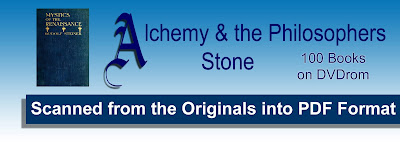See also Alchemy, the Philosopher's Stone and the Esoteric - 100 Books on DVDrom
For a list of all of my books on disk click here
In the opinion of the alchemists, or those who practised the pretended art of making gold and silver, all the metals are compound, the bases of them containing the same constituents of gold, but mixed with various impurities, which, being removed, the common metals were thought to assume the properties of gold. The change was said to be effected by what was called the "Philosopher's Stone," which is described as a red powder, with a peculiar smell. It was prepared by adding to the mercury of the adepts, philosophical gold, which, being left in a brooding furnace, becomes a black substance, then a white body, and being long and more fiercely heated, becomes yellow, and, finally, bright red. Now, the Stone so prepared could hardly have been anything but an amalgam of gold, which, if projected into melted lead or tin, and then cupellated (purified), would leave all the gold that existed previously in the amalgam. It might, therefore, have been employed by impostors to persuade the ignorant that it was merely the Philosopher's Stone; but the alchemists who prepared the amalgam could not be ignorant that it contained gold. Yet, although the existence of the Stone was regarded for centuries as a fact, no one pretended to possess it; each adept only maintaining that it was in the possession of another. Roger Bacon, the "Friar Bacon" of the story books, believed in the production of the Philosopher's Stone; and Arnold de Villeneuve professed that he could increase the Stone at pleasure. In 1455, Henry VI. granted patents and commissions to find out the Philosopher's Stone, "to enable the king to pay all the debts of the crown in real gold and silver." No gold, of course, was ever made, but the king had a forge or smithy built for practice in Pall Mall, on the site of the first Carlton House. Ripley, the alchemist, wrote on "the twelve gates" leading to the discovery of the Stone in 1470, but he repented his wasted life, and begged all men would burn his books, which were "false and vain." Basil Valentine, the German monk, was of the opinion that the metals were compounds of salt, sulphur, and mercury, and that the Philosopher's Stone was composed of the same ingredients. Cornelius Agrippa joined the French alchemists in searching for the Stone, as did Paracelsus in his youth, but he died in poverty when young. Dee and Kelly sought for the stones. Boyle and Sir Isaac Newton joined in a process for "multiplying gold," for which a company was established in London. Leibnitz joined a society of Rosicrucians in Nuremburg, in the pursuit of the Philosopher's Stone. Bergmann, the chemist, relates a number of cases in which gold was supposed to be formed by the use of the Philosopher's Stone; though they were the result of fraud by secretly introducing into the crucible gold, pretended to have been obtained by transmutation. Sometimes crucibles were made with a false bottom, gold or silver being concealed at the real bottom; when, heat being applied, the false bottom disappeared and the gold or silver was found at the bottom of the crucible. Sometimes gold or silver were introduced in charcoal— the hole stopped with wax—or in the hollow rods with which the crucible was stirred, the end being closed with wax. A common exhibition was to dip nails into a liquid, and take them out half converted into gold. These nails were one-half gold and one-half iron, the gold being covered with something to conceal its colour, which the liquid removed. Roger Bacon believed the Stone sufficed to transmute a million parts—according to Raymond Lulle, a thousand billions of parts—of a base metal into gold. Basil Valentine states its power at only seventy parts; and Dr. Price, the last alchemist, only thirty to sixty parts of the base metal into gold. There lived at Wilton, in Aubrey's time, "a great chemist," who had spent his fortune in long search for the Stone:—"After his death," says Aubrey, "they found in his laboratory there two or three baskets of egg-shells, which, I remember, Geber saith is a principal ingredient of that Stone." Ashmole, the antiquary, tells us that, in 1653, "Father Backhouse" told him in syllables the true matter of the Philosopher's Stone, which he bequeathed to him.
Lady Mary Wortley Montagu, in a letter dated January, 1717, records that "at Vienna there was a prodigious number of alchemists. The Philosopher's Stone is the great object of zeal and science; and those who have more reading and capacity than the vulgar, have transported their superstition (shall I call it that?) or fanaticism from religion to chemistry. This pestilential passion has already ruined several great houses. There is scarcely a man of opulence or fashion that has not an alchemist in his service; and even the emperor is supposed to be no enemy to this folly in secret, though he has pretended to discourage it in public." Nevertheless, some benefits have accrued to mankind from the ancient practice of an art which is now considered a low delusion and imposture. The books of the alchemists show the effects of experiments; and though they were guided by false views, they made most useful researches, and thus laid the foundation of experimental science and modern chemistry. Two centuries ago, Sir Thomas Browne regarded alchemical studies as the cradle of chemistry.



No comments:
Post a Comment